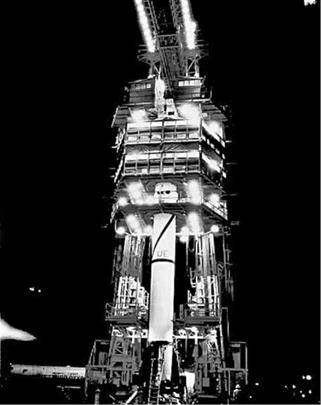The first countdown attempts
Countdowns were started during the two evenings before the successful launch. Wernher von Braun later recalled the general situation during the first attempt. He was in the Pentagon near Washington, D. C. General John B. Mederas, director of Huntsville’s Army Ballistic Missile Agency (ABMA) and von Braun’s immediate
245
OPENING SPACE RESEARCH
![]() boss, was also there, along with Pickering and Van Allen. A later account by Von Braun reads:
boss, was also there, along with Pickering and Van Allen. A later account by Von Braun reads:
On the evening of January 29, our firing party was assembled at Cape Canaveral. Dr. Kurt H. Debus and Dr. Hans F. Gruene, two veteran missile men, were in charge of the firing, and the JPL was represented by Dr. Jack Froehlich. Almost everyone was there except Bill Pickering, Jim Van Allen and me. We’d been ordered to Washington to meet the press after the launching had been announced.
It was a personal blow to me not to be able to be at the scene. But, I did keep in touch with the men in the blockhouse on several open telephone lines.
The first night was dreadful. Winds of 165 miles per hour began blowing at an altitude of 40,000 feet. We had to postpone the firing.1
The next day, I had more time to scout the situation, and discovered that members of the Vanguard team from the Naval Research Laboratory (NRL) had been there for some time preparing for a Vanguard launch. They had made an earlier launch attempt on 6 December, but, amid high expectations and intense publicity, their rocket had exploded on the launch pad.
The Vanguard team was working hard, by now with much less publicity, in preparing for their next attempt. A new countdown had progressed to within a few minutes of ignition a few days earlier, when they had been forced to abort. They continued to run into one delay after another, until the decision was made on 27 January to allow our Jupiter C to launch ahead of them.
I had worked closely over the previous two years with NRL’s Roger Easton and Marty Votaw while developing our Vanguard instrument, and we enjoyed a very pleasant and productive working relationship and personal friendship. They had set up a Vanguard receiving station at the Cape in Hangar S to support their own project, and had checked out their receiver to verify that it could decode our Deal I signals.
Roger and Marty graciously invited me to join them. Thus, through their hospitality and goodwill, I found a place aside from any JPL facility to track the performance of my Deal I instrument during its second and third countdowns. I vividly recall the three of us sitting on stools at a workbench in their laboratory. I listened to the telemetered signals from my instrument while, at the same time, hearing the progress of the countdown from a loudspeaker connected to the Cape’s intercom system.
For the second countdown, I began writing down in my notebook the information from the cosmic ray counter, as it sat atop the launch vehicle. After every 32 pulses from the GM counter, the telemetered tone shifted. I simply wrote down the time of each transition. As it turned out for that second attempt, I happened to start recording the data just four minutes before the countdown was scrubbed.
|
CHAPTER 9 • THE BIRTH OF EXPLORER I
FIGURE 9.1 The Jupiter C launch vehicle with the servicing gantry still in place during the early evening of 31 January 1958. At about 30 minutes before launch, the gantry was moved back. The vehicle successfully launched Explorer I. (Courtesy of the NASA Marshall Space Flight Center.) |
That happened at 6:55 PM EST. Quoting again from von Braun’s account:
The next night was worse. The winds were up to 225 miles per hour. Again, we had to postpone. And the predictions were for days more of the same.











